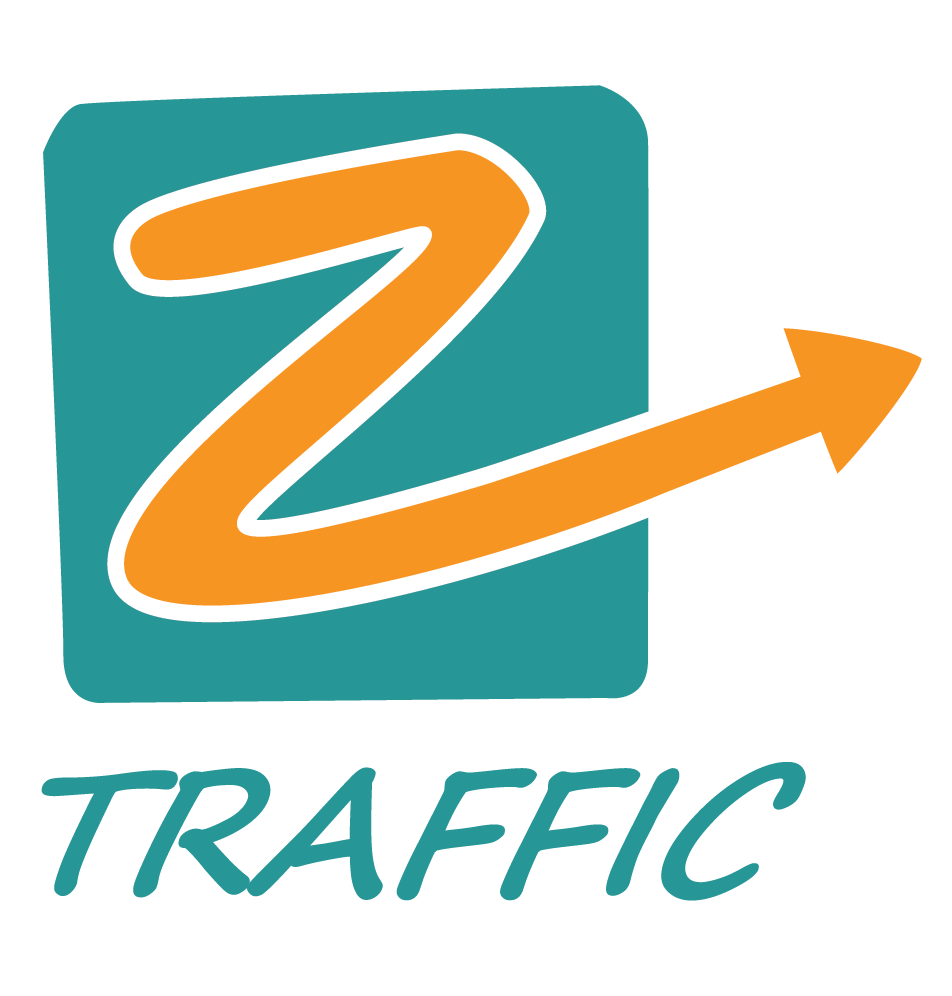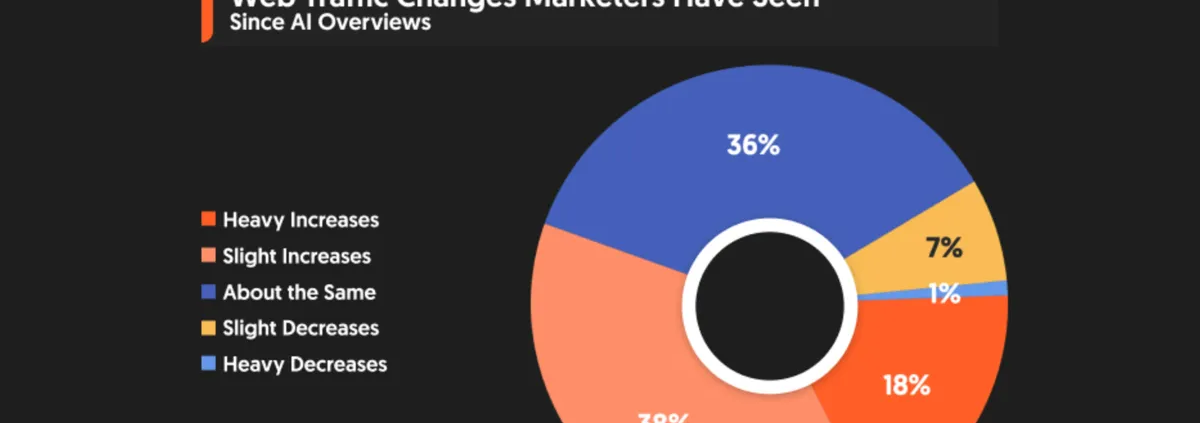Marketing concerns over AI search may be overblown, study finds – PPC Land
NP Digital research set to be released next week challenges industry fears about traffic devastation.
Widespread concerns about artificial intelligence destroying website traffic may be overestimated, according to new data from NP Digital scheduled for release next week. The comprehensive study reveals that 55.5% of marketers report increased traffic since the introduction of AI Overviews, while 36.2% observe stable traffic levels. Only 8.3% experienced traffic declines.
The findings present a stark contrast to earlier industry predictions and reports of traffic devastation. NP Digital’s 2025 Search Engine Trends report, which surveyed 600 U.S. marketers and 1,000 general users, suggests the impact of AI-powered search features appears more nuanced than initially feared.
The traffic data contradicts predictions of widespread website abandonment following AI Overview implementation. Among marketers reporting increases, 17.7% describe heavy traffic growth while 37.8% note slight improvements. Those experiencing stable traffic represent the largest single group at 36.2%.
Marketers reporting decreases split into modest declines. According to NP Digital, 7% observe slight decreases while only 1.3% report heavy traffic losses. These figures suggest that while some websites face challenges, the majority maintain or improve their organic reach despite AI-powered search features.
The data becomes more significant when compared to previous research showing 34.5% organic click reductions in studies examining AI Overview impact. The discrepancy between click-through rate studies and marketer-reported traffic changes indicates measurement complexities in the AI search environment.
ChatGPT dominates marketer attention for AI search visibility monitoring. According to NP Digital’s research, 68% of marketers currently focus on ChatGPT/OpenAI platforms for tracking search presence. This represents a dramatic shift from traditional Google-centric monitoring approaches.
AI Overviews capture significantly less marketer focus despite Google’s market dominance. Only 17% of surveyed marketers actively track visibility within Google’s AI-powered search summaries. Perplexity follows at 10%, while You.com captures 4% of marketer attention and Microsoft Copilot reaches 3%.
The concentration on ChatGPT reflects practical considerations beyond platform size. ChatGPT provides more transparent referral traffic attribution compared to Google’s AI Overviews, which often generate zero-click experiences. Marketers can measure actual visitor flow from ChatGPT searches, while AI Overview appearances may not translate to website visits.
This tracking preference also indicates strategic positioning for future growth. Industry analysis suggests ChatGPT could potentially overtake Google search traffic by 2030, making early optimization efforts particularly valuable for long-term visibility strategies.
Marketing professionals demonstrate rapid adaptation to AI search changes. NP Digital’s data shows 57% of marketers have modified their SEO or content strategies since AI Overviews launched, indicating widespread recognition of the shifting search landscape.
The remaining 43% who have not yet adjusted strategies may face increasing pressure to adapt. Early adopters often capture disproportionate advantages in new technology environments, while late movers risk visibility losses as AI algorithms develop preferences for optimized content formats.
Strategic changes encompass multiple optimization approaches. Content restructuring focuses on AI-friendly formats, while technical implementations target improved visibility across various AI platforms. These adaptations require significant resource allocation, suggesting marketers view AI search as a permanent rather than temporary shift.
The speed of strategic adaptation reflects the urgency marketing teams feel about maintaining search visibility. Unlike previous algorithm updates that affected specific ranking factors, AI search introduces fundamental changes to how users discover and consume information online.
Manual SERP spot-checking emerges as the primary method for tracking AI search visibility. According to NP Digital, 58% of marketers employ manual observation techniques to monitor their content’s appearance in AI-powered search results.
This manual approach reflects the current limitation of automated tracking tools. Traditional SEO software has not yet developed comprehensive AI Overview monitoring capabilities, forcing marketers to rely on human observation for visibility assessment.
Google Analytics traffic analysis ranks second at 55% usage among marketers. This method provides indirect measurement of AI search impact through traffic pattern changes rather than direct visibility tracking. Marketers examine referral sources, user behavior metrics, and conversion patterns to infer AI search influence.
Google Search Console monitoring captures 51% of marketer attention for AI impact assessment. Search Console provides impression and click data that can indicate AI Overview presence, though it does not explicitly identify when AI features appear alongside traditional results.
Brand mentions have evolved into a fundamental component of AI search strategy. NP Digital’s research reveals that 78% of marketers consider brand mentions either extremely important (46%) or moderately important (32%) for search visibility in AI-powered environments.
This emphasis on brand mentions reflects how AI algorithms prioritize entity recognition and source credibility. Large language models often reference branded sources when generating responses, making brand visibility crucial for AI search presence.
Marketers employ diverse tactics for building brand mention strategies. According to the study, 65% of marketers actively build brand mentions as part of their current SEO strategy, while 25% plan to implement brand mention campaigns. Only 10% have not yet considered brand mention optimization.
The brand mention focus represents a shift from traditional keyword-based SEO toward authority and recognition building. PPC Land previously reported the importance of brand signals in AI search environments, where algorithms prioritize trusted sources over keyword optimization alone.
Advanced tracking methodologies demonstrate sophisticated AI search understanding among marketing professionals. Social listening tools capture 46% usage for monitoring brand mentions across digital platforms, indicating integration between traditional PR measurement and search optimization.
Structured data and schema markup implementation reaches 36% adoption among surveyed marketers. This technical approach helps search engines and AI systems understand content context, potentially improving visibility in AI-generated responses.
Competitor visibility monitoring captures 33% of marketer attention. Understanding how competing brands appear in AI search results provides strategic intelligence for optimization improvements and competitive positioning.
SERP feature tracking tools achieve 30% usage despite their limitation in AI search environments. Traditional SERP tools designed for featured snippets and knowledge panels require adaptation for comprehensive AI Overview monitoring.
General users demonstrate diverse search behavior patterns beyond traditional search engines. YouTube commands the highest usage at 63% among consumers seeking information outside conventional search platforms, reflecting video content’s growing importance for information discovery.
ChatGPT/SearchGPT captures 39% of consumer usage for alternative search activities. This substantial adoption rate indicates mainstream acceptance of AI-powered search tools among general users, not just technology early adopters.
Facebook maintains relevance for information seeking at 33% usage, followed by Amazon at 27%. These platforms serve different information needs, with Facebook focusing on social recommendations and Amazon dominating product-related searches.
Reddit and Voice Search each achieve 24% usage rates. Reddit’s popularity for authentic user discussions complements voice search adoption for convenience-driven queries, showing how different platforms serve distinct user intentions.
Food and cooking content generates the highest social search engine usage at 42% among consumers. This preference reflects the visual and community-driven nature of culinary content, where social platforms provide superior discovery experiences compared to traditional search.
DIY and hobby content follows at 37%, benefiting from social media’s strength in tutorial and inspiration content. These practical topics often require step-by-step guidance and community feedback that social platforms deliver effectively.
Shopping queries reach 36% social search usage, indicating consumer preference for peer recommendations and visual product discovery. Social platforms provide social proof and authentic reviews that traditional search results may lack.
Current events capture 35% of social search activity. Social media platforms often provide real-time information and diverse perspectives on developing news stories, complementing traditional news sources with immediate community reaction and analysis.
AI Overview satisfaction levels reveal measured consumer acceptance rather than overwhelming enthusiasm. NP Digital’s data shows 30% of users express clear satisfaction with AI-powered search features, while 37% report somewhat positive experiences.
Neutral responses account for 25% of consumer feedback, suggesting many users remain undecided about AI search benefits. This substantial neutral segment represents potential growth opportunity as AI search features improve and users develop familiarity with new capabilities.
Dissatisfaction remains limited at 8% of users, indicating that while AI search may not generate universal enthusiasm, it does not create widespread user frustration. This relatively low dissatisfaction rate supports continued AI search development and expansion.
The balanced satisfaction distribution suggests AI search adoption will likely continue gradually rather than through rapid user migration. Marketing strategies should account for this measured adoption pace when planning AI optimization investments.
AI Overview accuracy issues affect one quarter of general users according to NP Digital’s research. These error encounters highlight the ongoing refinement needed in AI-generated search responses and their potential impact on user trust.
Inaccurate answers represent the most common error type at 51% of reported issues. These factual mistakes can undermine user confidence in AI search results and may drive users back to traditional search methods for verification.
Outdated information accounts for 21% of AI Overview errors. This challenge reflects the difficulty of maintaining current information in large language models, particularly for rapidly changing topics like news, prices, and current events.
Inappropriate answers comprise 20% of error reports, while irrelevant information represents 6%. These categories suggest both content filtering challenges and query understanding limitations that may improve with continued algorithm development.
Traffic diversification strategies gain momentum among marketing teams responding to AI search changes. According to NP Digital, 54.5% of marketers actively explore alternative channels including paid social, native advertising, and email marketing to offset potential organic losses.
Another 14.8% report having already diversified their traffic sources before AI search implementation. These early adopters may provide competitive advantages as AI search continues evolving and potentially affecting organic traffic patterns.
The remaining 30.7% have not yet pursued diversification strategies. This group may face increased vulnerability if AI search continues reducing traditional organic traffic to their websites, particularly for information-focused content.
Diversification efforts reflect sophisticated understanding of changing digital marketing landscapes. Rather than relying exclusively on search optimization, successful marketers build resilient traffic portfolios across multiple channels and platforms.
Direct referral traffic from AI tools demonstrates tangible business value for marketing professionals. NP Digital’s data indicates 24.3% of marketers receive consistent referral traffic from AI tools and language models, while 39.3% report occasional traffic from these sources.
This 63.6% combined rate of AI referral traffic suggests widespread integration between AI search platforms and traditional websites. Unlike AI Overviews that may generate zero-click experiences, AI chatbots frequently direct users to external sources for detailed information.
Another 19.8% of marketers actively track for future AI referral opportunities without currently receiving measurable traffic. This tracking preparation indicates expectation of growing AI referral volume as these platforms expand their user bases.
Only 16.5% of surveyed marketers neither receive nor track AI-driven referrals. This group may miss opportunities for early optimization and relationship building with emerging AI search platforms.
Content optimization for AI search environments shows sophisticated implementation across marketing teams. Clear, concise answers positioned prominently on pages rank as the primary optimization technique among 87% of surveyed marketers.
Heading structure optimization achieves 76% adoption, with marketers crafting headers that mirror common search queries. This approach helps AI algorithms identify relevant content sections for inclusion in generated responses.
Schema markup implementation reaches 73% usage among marketers optimizing for AI search. Structured data helps search engines and AI systems understand content context, relationships, and authority signals that influence visibility decisions.
E-E-A-T signal optimization captures 65% of marketer attention. Expertise, Experience, Authoritativeness, and Trustworthiness factors have gained importance as AI systems prioritize credible sources for information synthesis and recommendation.
Conversational tone adoption and content freshness strategies each achieve 58% implementation rates. These approaches reflect understanding that AI search often favors natural language patterns and current information over traditional keyword-optimized content.
The study’s findings challenge prevailing industry narratives about AI search causing uniform traffic devastation. Instead, NP Digital’s research suggests a complex transformation requiring strategic adaptation rather than defensive positioning. Marketing professionals who implement comprehensive tracking and optimization approaches appear positioned to maintain or improve their search performance in AI-powered environments.
The data release next week will provide the marketing community with concrete metrics for evaluating AI search impact beyond anecdotal reports and limited case studies. These findings may influence industry strategies for 2025 and beyond as AI search continues expanding across global markets.
AI Overviews represent Google’s implementation of artificial intelligence directly within search results pages. These features generate comprehensive answers using multiple sources, appearing above traditional organic listings. AI Overviews fundamentally alter user interaction with search results by providing immediate answers that may eliminate the need to visit external websites. The feature has become central to discussions about traffic impact and represents Google’s most significant search interface change since the introduction of featured snippets.
ChatGPT/SearchGPT encompasses OpenAI’s conversational search capabilities that have captured significant marketer attention. Unlike traditional search engines that return lists of links, ChatGPT provides direct answers through natural language interaction. The platform’s transparency in referral traffic attribution makes it particularly attractive for marketing measurement, while its rapid user growth suggests long-term strategic importance for search visibility efforts.
Traffic diversification describes strategic efforts by marketing professionals to reduce dependence on organic search traffic through alternative channels. This approach includes paid social media, native advertising, email marketing, and direct audience building. The concept has gained urgency as AI search features potentially reduce traditional website visits, forcing marketers to build resilient traffic portfolios across multiple platforms and touchpoints.
Brand mentions have evolved from traditional PR metrics to critical components of AI search optimization. These references help establish entity recognition and source credibility within large language models. Marketing teams increasingly focus on building brand mention strategies because AI algorithms prioritize recognized sources when generating responses, making brand visibility essential for inclusion in AI-generated content.
SERP spot-checking refers to manual observation techniques marketers use to monitor content appearance in search results, particularly for AI-powered features. This manual approach has become necessary due to limitations in automated tracking tools that have not yet adapted to comprehensive AI Overview monitoring. The technique involves systematic observation of search results to assess visibility and competitive positioning.
Schema markup represents structured data implementation that helps search engines and AI systems understand content context and relationships. This technical approach has gained importance in AI search environments where algorithms need clear content categorization for accurate information synthesis. Proper schema implementation can improve content eligibility for inclusion in AI-generated responses and enhance visibility across various search features.
E-E-A-T signals encompass Expertise, Experience, Authoritativeness, and Trustworthiness factors that have become increasingly important for AI search optimization. These quality indicators help AI systems identify credible sources for information synthesis and recommendation. Marketing professionals focus on E-E-A-T development because AI algorithms prioritize content from recognized experts and authoritative sources over purely keyword-optimized material.
Zero-click searches describe queries resolved entirely within search interfaces without directing users to external websites. This phenomenon has intensified with AI search implementation, where comprehensive answers appear directly in search results. The concept represents a fundamental shift in search behavior that challenges traditional website monetization models and requires new approaches to content strategy and audience engagement.
Referral traffic from AI platforms represents measurable website visits originating from AI-powered search tools and chatbots. Unlike zero-click experiences, referral traffic demonstrates direct business value through actual user visits and potential conversions. This traffic type has become increasingly important for measuring AI search impact and optimizing for platforms that provide transparent attribution.
Manual SERP observation constitutes the primary method marketers currently use for tracking AI search visibility due to technological limitations in automated monitoring tools. This approach requires systematic checking of search results to identify when content appears in AI-generated responses. The technique represents a temporary solution while the industry develops more sophisticated tracking capabilities for AI search environments.
Subscribe the PPC Land newsletter ✉️ for similar stories like this one. Receive the news every day in your inbox. Free of ads. 10 USD per year.
Who: NP Digital will release the research next week, having surveyed 600 U.S. marketers and 1,000 general users. The study impacts digital marketing professionals, SEO practitioners, content creators, and website owners navigating AI-powered search environments.
What: A comprehensive analysis revealing that concerns about AI search decimating website traffic may be overblown. The upcoming study shows 55.5% of marketers report increased traffic since AI Overviews launched, while 36.2% observe stable traffic levels. Only 8.3% experienced decreases.
When: The study will be released next week, examining marketer and consumer behavior patterns throughout the AI search transition period that began accelerating in 2024.
Where: The research focuses on U.S. marketing professionals and consumers, with implications for global digital marketing strategies and search optimization practices across AI-powered platforms.
Why: The study addresses widespread industry concerns about AI search features destroying website traffic and advertising revenue. The findings suggest more nuanced outcomes requiring strategic adaptation rather than catastrophic loss, providing data-driven insights for marketing professionals developing AI search strategies.








